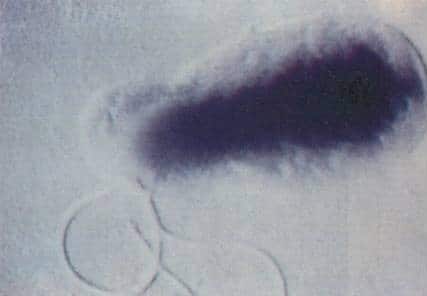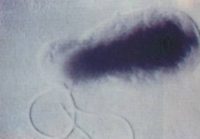
21 Mar Case of Sudden Onset Schizophrenia Linked to Cat Scratch Fever Bacteria
MedicalResearch.com Interview with:
Dr. Ed Breitschwerdt, DVM, DACVIM
Melanie S. Steele Distinguished Professor of Internal Medicine
NC State
MedicalResearch.com: What is the background for this case report? Can you briefly explain the signs/symptoms of a Bartonella infection?
Response: Bartonella henselae is a bacteria most commonly associated with cat scratch disease, which until recently was thought to be a short-lived (or self-limiting) infection. There are now at least 40 different known species of Bartonella, 13 of which have been found to infect human beings. The ability to find and diagnose Bartonella infection in animals and humans – it is notorious for “hiding” in the linings of blood vessels – has led to its identification in patients with a host of chronic illnesses ranging from migraines to seizures to rheumatoid illnesses, some of which the medical community previously hadn’t been able to attribute to a specific cause. Evolving data suggests a role for these bacteria in a spectrum of cardiovascular, neurological and rheumatological diseases. Specific symptoms or diseases that have been reported with neurobartonellosis previously include encephalitis, headaches, migraines, demyelinating polyneuropathy, neuroretinitis and transverse myelitis. Documentation of Bartonella henselae blood stream infection in a boy diagnosed with Schizophrenia and Pediatric Acute-onset Neuropsychiatric Syndrome (PANS) extends the spectrum of symptomatology associated with neurobartonellosis.
MedicalResearch.com: What are the main findings?
Response: In a case study published in the Journal of Central Nervous Disease, an adolescent a 14-year-old boy with sudden onset psychotic behavior – diagnosed as schizophrenia – was seen and treated by numerous specialists and therapists over an 18-month period. Conventional treatments for both psychosis and autoimmune encephalitis failed. Finally a physician recognized lesions on the patient’s skin that have previously been associated with Bartonella infections, and our research laboratory was contacted to pursue diagnostic confirmation. After an almost 2 year illness, the boy was diagnosed with bartonellosis based on amplification of B. henselae DNA from his blood and from an enrichment blood culture. Interestingly, he did not have antibodies to B. henselae on repeat testing. Targeted combination antimicrobial therapy was started, and the boy subsequently made a full recovery.
MedicalResearch.com: What should readers take away from your report?
Response: This case is interesting for a number of reasons.
First, although causation cannot be established by a case report, the medial management of this patient provides support for a connection between neuropsychiatric disease and Bartonella infection. Specifically, this case report suggests that Bartonella infection could contribute to progressive neuropsychiatric disorders like schizophrenia.
Secondly, our findings raise the question of how often infection with unknown or difficult to detect organisms may be involved with neurocognitive or neuropsychiatric disorders in general. As an example, researchers around the world are investigating the potential role of infection in Alzheimer’s disease. Thus, beyond this one case, there are evolving efforts to better understand the potential role of viral and bacterial infections in these chronic, costly and medically complex diseases.
Finally, and perhaps most importantly, this case report emphasizes the need for future systematic investigations into the role of Bartonella in neuropsychiatric diseases like schizophrenia.
MedicalResearch.com: What recommendations do you have for future research as a result of this study?
Response: There is a tremendous need for biomedical research that will improve diagnostic detection, define optimal treatment protocols and institute strategies to prevent human Bartonella spp. infections. We are thus excited to announce a new collaboration with Dr. Flavio Frohlich, associate professor of psychiatry, neurology, and cell biology and director of the Carolina Center for Neurostimulation at UNC – Chapel Hill. Our new study will examine the prevalence of Bartonella in patients with schizophrenia.
MedicalResearch.com: Is there anything else you would like to add?
Response: Prior to 1990, no Bartonella species had ever been associated with an animal or human infection in North America. Discovery of these bacteria was a direct result of the AIDS epidemic. Based upon scientific and medical research, the number of named Bartonella species has grown from just two in 1990 to at least 40 species or subspecies currently. Bartonella are vector-borne pathogens, and early studies of the first discovered species found transmission by sandflies (Bartonella bacilliformis) and the human body louse (Bartonella quintana).
However, it is now clear that the wide variety of Bartonella species are transmitted by a similarly numerous collection of arthropods: biting flies, fleas, mites, ticks, and potentially ants, bedbugs, bees and spiders. Bartonella spp. have co-evolved in many instances in conjunction with one or more arthropod vector and one or more animal reservoir host. Through evolutionary adaptation, reservoir hosts can remain infected for months to years. In most instances, the disease bartonellosis or neurobartonellosis occurs when the bacteria is transmitted from a reservoir host to a non-reservoir host, such as a human. Based upon the increasing number of named Bartonella species, the large number of reservoir-adapted hosts, and the broad spectrum of arthropod vectors that are being implicated in transmission of these bacteria among animals and humans, it is likely that the genus Bartonella is causing substantially more chronic illnesses worldwide than is currently appreciated.
Disclosure: Dr. Breitschwerdt is a Founder, Shareholder and Chief Scientific Officer for Galaxy Diagnostics, Research Triangle Park, NC
Citation:
Bartonella henselae Bloodstream Infection in a Boy With Pediatric Acute-Onset Neuropsychiatric Syndrome
DOI: https://doi.org/10.1177/1179573519832014
Authors: Ed Breitschwerdt, Ricardo Maggi, Julie Bradley, North Carolina State University; Rosalie Greenberg, Medical Arts Psychotherapy Associates; Robert Mozayeni, Translational Medicine Group; Allen Lewis, Sancta Familia Center for Integrative Medicine
Published: Journal of Central Nervous System Disease
The information on MedicalResearch.com is provided for educational purposes only, and is in no way intended to diagnose, cure, or treat any medical or other condition. Always seek the advice of your physician or other qualified health and ask your doctor any questions you may have regarding a medical condition. In addition to all other limitations and disclaimers in this agreement, service provider and its third party providers disclaim any liability or loss in connection with the content provided on this website.
Last Updated on March 21, 2019 by Marie Benz MD FAAD

